Brewing Beer with Dehusked Carafa Malt
Published: July 24, 2025 at 7:37:07 AM UTC
Last updated: December 9, 2025 at 7:33:04 PM UTC
Using Dehusked Carafa malt in brewing beer offers a unique chance to achieve a rich, smooth roast flavor with less bitterness. This malt is perfect for brewers aiming to craft a wide array of beer styles. From dark lagers to black IPAs, it helps avoid the astringency often linked with roasted malts. By adding Dehusked Carafa to their recipes, brewers can significantly enhance their beer's flavor profile. They can achieve a deeper, smoother character. This malt is ideal for those wanting to brew beers with complex flavors without excessive bitterness.
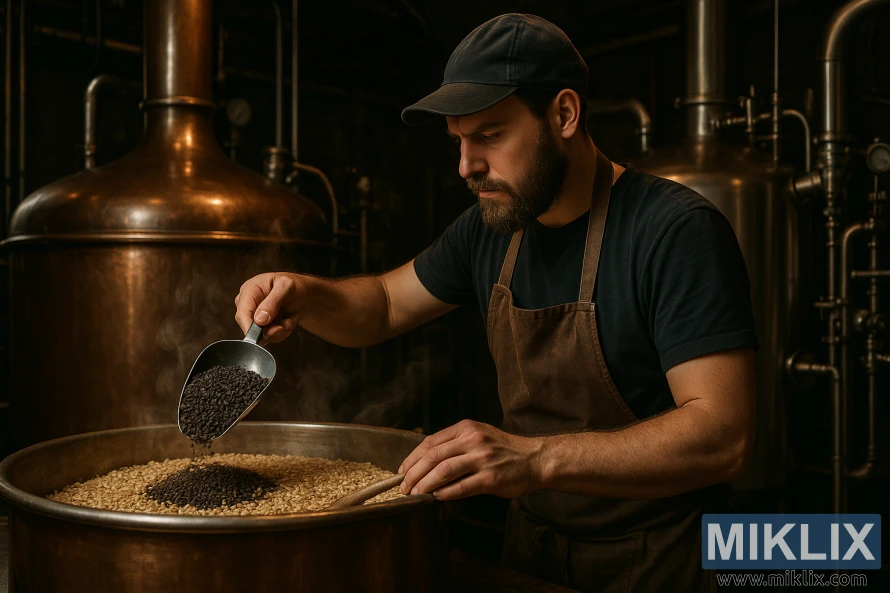
Key Takeaways
- Dehusked Carafa malt provides a smooth roast flavor with less bitterness.
- It is versatile and can be used in various beer styles.
- Brewing with Dehusked Carafa can result in beers with rich, complex flavor profiles.
- This malt is ideal for brewers seeking to reduce astringency in their beers.
- Dehusked Carafa is suitable for brewing dark lagers and black IPAs.
Understanding Dehusked Carafa Malt
The dehusking of Carafa malt significantly alters its brewing properties. Dehusked Carafa malt, with its outer husk removed, offers a smoother taste. This transformation is achieved through a decorticator, an abrasive machine that strips away the grain's exterior layers.
By eliminating the husk, Dehusked Carafa reduces bitterness and astringency. This makes it perfect for beers that need a smooth, roast flavor. Brewers find it invaluable for adding depth without the harshness of traditional roasting.
Grasping the essence of Dehusked Carafa malt requires understanding its production. The decortication process not only refines the flavor but also influences its brewing characteristics. It impacts how it interacts with other ingredients and the final beer's taste and quality.
Dehusked Carafa malt stands out for its versatility in brewing. It suits a range of beer styles where a refined, roasted taste is sought. Its unique qualities make it a go-to for brewers aiming to create distinctive and innovative brews.
The History and Development of Carafa Malts
The journey of Carafa malts started in the 16th century, beginning a rich brewing tradition. For centuries, brewers have harnessed Carafa malts, with the first use noted in the 16th century. Through time, brewers have refined techniques for processing and utilizing Carafa malts, including the innovation of Dehusked Carafa malt.
This evolution has allowed brewers to craft a broader spectrum of beer styles with enhanced flavor profiles. The progression of Carafa malts has been influenced by advancements in malting technology and a deeper comprehension of malting techniques' effects on the final product.
The advent of Dehusked Carafa malt has significantly expanded brewing possibilities. By eliminating the husk, brewers can produce beers with smoother, less bitter flavors. This has made Dehusked Carafa a favorite among brewers aiming to create complex, nuanced brews.
The history and evolution of Carafa malts reflect the ingenuity and skill of brewers through the ages. As brewing methods continue to advance, Carafa malts are set to remain a cornerstone in the brewing world.
Benefits of Using Dehusked Carafa in Brewing
Dehusked Carafa malt brings several benefits to brewing, including a smoother flavor profile. Its primary advantage is the reduction in bitterness and astringency. This makes it perfect for brewing beers with a smooth roast flavor.
This characteristic allows brewers to achieve a rich, complex flavor profile without harshness. Dehusked Carafa malt is versatile, suitable for a wide range of beer styles. From dark lagers to black IPAs, it offers brewers endless possibilities.
The smoother flavor profile of Dehusked Carafa malt is a boon for brewers. It's ideal for creating beers with deep, roasted flavors without the bitterness. This makes it a top choice for brewers looking to innovate and try new recipes.
- Reduced bitterness and astringency
- Smooth roast flavor profile
- Versatility in brewing various beer styles
By using Dehusked Carafa malt, brewers can elevate the quality and character of their beers. This appeals to a broad range of consumer tastes.
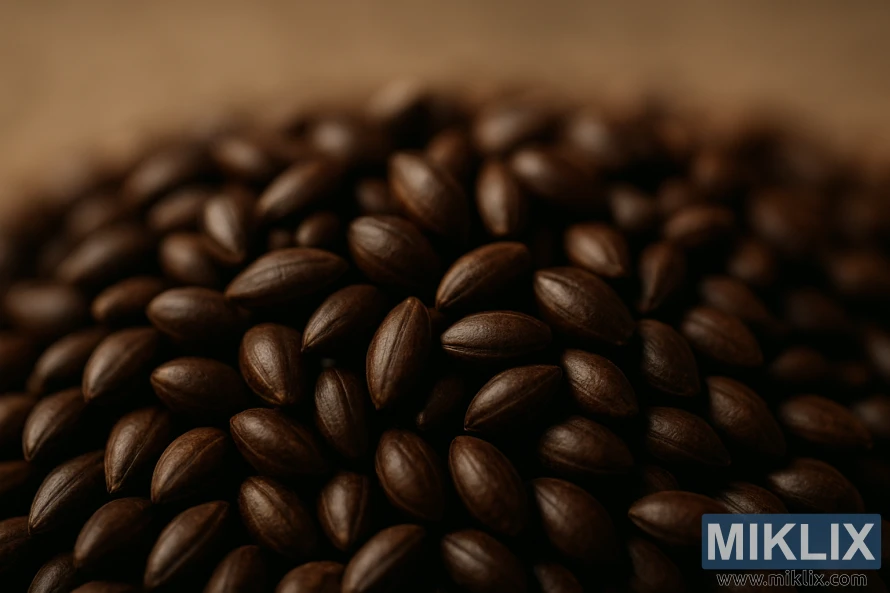
Comparing Regular Carafa vs Dehusked Carafa
The difference between regular Carafa malt and Dehusked Carafa can greatly affect your beer's taste. Regular Carafa malt is celebrated for its strong flavor and deep color. It's a key ingredient in brewing dark beers.
Dehusked Carafa, by contrast, provides a milder taste with less bitterness. This makes it perfect for brewers seeking a smooth roast flavor without the harshness of regular Carafa.
Brewers need to think about the flavor they want to achieve. Regular Carafa is great for beers needing a bold, dark malt taste. But for brews that want a smooth, roasted taste, Dehusked Carafa is the better choice.
- Regular Carafa: Robust flavor, dark color, suitable for dark beers.
- Dehusked Carafa: Smooth flavor profile, reduced bitterness, ideal for smooth roast flavors.
Knowing these differences helps brewers make better choices. It impacts the quality and character of their beer.
Optimal Beer Styles for Dehusked Carafa
Dehusked Carafa is a specialty malt that opens up a world of possibilities for brewers. Its unique traits make it perfect for a variety of beer styles.
It's commonly used in brewing dark lagers and black IPAs. These styles gain from Dehusked Carafa's smooth flavor and reduced bitterness. This results in complex, balanced beers.
The smooth roast flavor of Dehusked Carafa is ideal for dark lagers. It adds depth without harsh bitterness. In black IPAs, it balances the flavor, complementing hoppy notes with rich, malty undertones.
Other beer styles that benefit from Dehusked Carafa include:
- Porters
- Stouts
- Schwarzbier
These styles all take advantage of Dehusked Carafa's unique qualities. It's a versatile ingredient for brewers.
Technical Specifications and Usage Rates
Grasping the technical details of Dehusked Carafa malt is key to perfecting your brew. This malt stands out with its unique color, diastatic power, and other specs that shape its brewing role.
The color of Dehusked Carafa is a major player, affecting the beer's final hue. It boasts a very dark color, measured in EBC or Lovibond units. Its diastatic power, showing its starch-to-sugar conversion ability, is also vital.
Usage rates for Dehusked Carafa are generally lower than other malts. The exact amount needed varies by beer style and flavor goals. Typically, brewers add 1-5% of Dehusked Carafa to their total grain bill.
Knowing the technical specs and usage guidelines for Dehusked Carafa empowers brewers. It allows them to craft beers with the right color, taste, and character.
Mashing Techniques with Dehusked Carafa
Brewing with Dehusked Carafa requires a deep understanding of various mashing techniques. Mashing is a key step in brewing, and Dehusked Carafa can be used in different ways to achieve the best results.
Two common mashing techniques with Dehusked Carafa are step mashing and decoction mashing. Step mashing involves temperature rests to activate enzymes and extract sugars. Decoction mashing removes a portion of the mash, boils it, and then returns it to the main mash for the desired temperature.
The choice of mashing technique depends on the brewer's goals and equipment. By understanding the different techniques, brewers can optimize their process and get the best results with Dehusked Carafa.
Effective mashing techniques help extract the maximum flavor and fermentable sugars from Dehusked Carafa. This results in a high-quality beer.
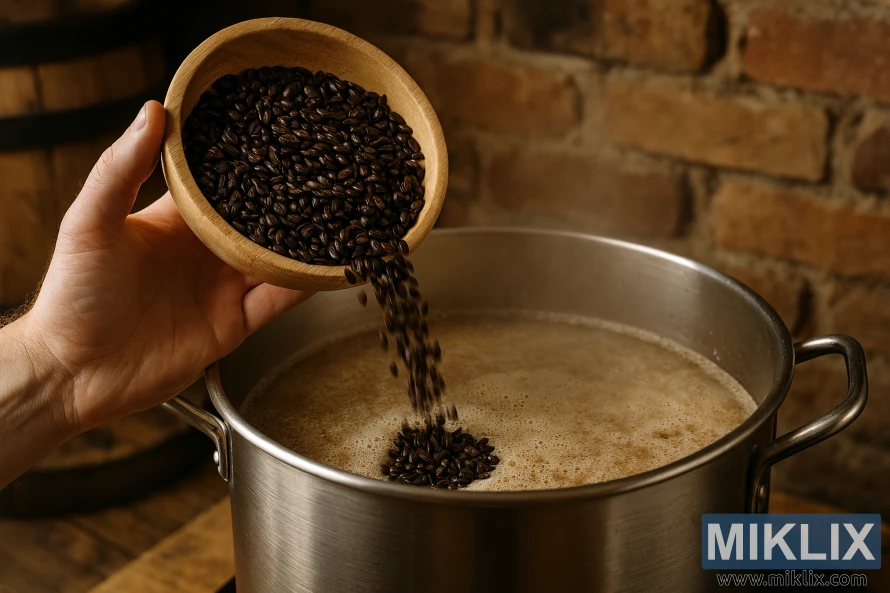
Recipe Formulation Guidelines
Creating recipes with Dehusked Carafa demands a thorough grasp of its taste and brewing traits. It boasts a smooth roast flavor and less bitterness, perfect for many beer styles. This includes dark lagers and Schwarzbier.
Brewers should think about Dehusked Carafa's usage rates when crafting recipes. It's commonly used between 5% to 20% of the total grain mix. For instance, a Schwarzbier recipe might use 10% Dehusked Carafa. This adds a deep color without too much bitterness.
Choosing the right ingredients alongside Dehusked Carafa is key. Hops should balance its sweetness. Yeast strains that boost the beer's depth without masking the malt's taste are best. For example, noble hops can add a subtle bitterness that complements Dehusked Carafa's smooth roast.
Optimizing the brewing process is also vital. Brewers might use a multi-step mash or a single infusion mash at a higher temperature. This helps extract the desired flavors from Dehusked Carafa. The aim is to create a balanced beer that showcases the malt's unique qualities.
- Consider the flavor profile and usage rates of Dehusked Carafa when formulating recipes.
- Select complementary hops and yeast to enhance the beer's overall character.
- Optimize the mashing technique to extract the desired flavors from the malt.
By adhering to these guidelines, brewers can craft complex, balanced beers that highlight Dehusked Carafa's unique traits. Whether making a traditional Schwarzbier or exploring new recipes, this malt opens up a world of possibilities for craft brewers.
Impact on Beer Color (SRM/EBC)
Dehusked Carafa is a versatile malt, perfect for beers ranging from dark amber to black. Its impact on beer color is profound, allowing brewers to adjust its usage for the desired hue. This versatility makes Dehusked Carafa a top choice for crafting beers like dark lagers or black IPAs.
The color of beer is measured in SRM (Standard Reference Method) or EBC (European Brewery Convention) units. Dehusked Carafa can significantly influence these values, depending on its quantity and brewing techniques. By tweaking the Dehusked Carafa's proportion in the grist, brewers can precisely control their beer's color. This ensures the beer's visual appeal meets their expectations.
In summary, Dehusked Carafa gives brewers significant control over beer color. It's a key ingredient for creating beers with unique and captivating color profiles.
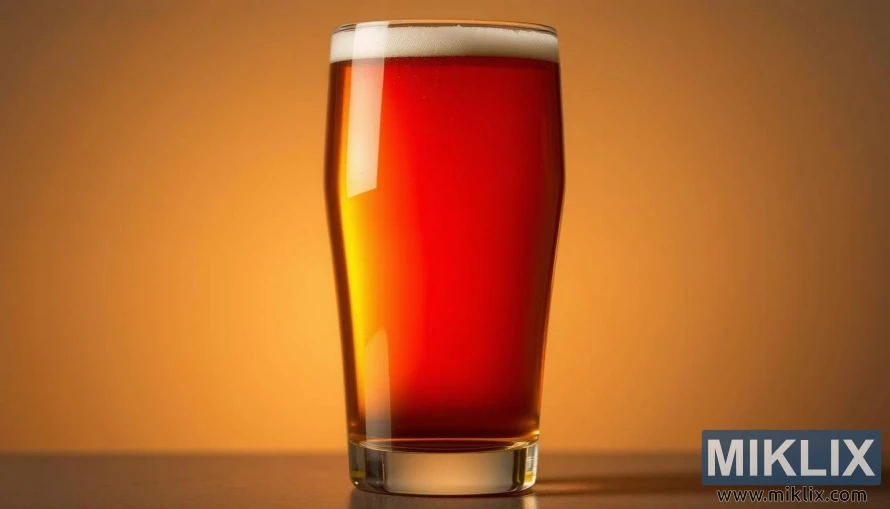
Common Brewing Challenges and Solutions
Brewing with Dehusked Carafa presents several challenges. Achieving a consistent flavor profile is a major hurdle. The unique characteristics of Dehusked Carafa can lead to taste variability if not managed correctly.
To overcome this, brewers should focus on a few key strategies. First, proper storage of Dehusked Carafa is essential. It should be kept in a cool, dry place to preserve its quality.
- Inconsistent Flavor Profiles: Use precise measurement and monitoring of the brewing process to maintain consistency.
- Poor Head Retention: Adjust the recipe to include ingredients that enhance head retention, such as certain types of wheat malt.
- Over-Extraction: Monitor mash temperatures and times closely to avoid over-extraction, which can lead to unwanted flavors.
Understanding these common challenges and implementing the right solutions is key. Brewers can optimize their use of Dehusked Carafa and achieve high-quality results. This requires proper storage, precise brewing techniques, and recipe adjustments as needed.
Quality Control Measures
Quality control is essential in brewing with Dehusked Carafa. It directly affects the beer's quality and character. Ensuring the malt's quality is critical, as it impacts the brewing process and the final product.
To maintain brewing quality, several key measures should be implemented:
- Regularly inspect the Dehusked Carafa malt for any signs of spoilage or contamination.
- Monitor the brewing process closely, adjusting parameters as necessary to optimize the use of Dehusked Carafa.
- Implement effective sanitation and cleaning protocols to prevent contamination.
By focusing on these quality control measures, brewers can ensure their beer meets the highest standards. This includes maintaining detailed records of the brewing process and conducting regular quality checks on the final product.
Some key benefits of rigorous quality control include:
- Improved consistency in the final beer product.
- Enhanced flavor profiles due to optimized brewing conditions.
- Reduced risk of contamination or spoilage.
By prioritizing quality control measures, brewers can maximize the Dehusked Carafa malt's full range. This results in high-quality beers that meet consumer expectations.
Flavor Integration with Other Malts
The art of blending Dehusked Carafa with other malts requires understanding how their flavors interact. By mixing Dehusked Carafa with specialty malts, brewers can craft complex, balanced flavors. These enhance the overall character of their beers.
Dehusked Carafa can be combined with various specialty malts, like chocolate or crystal malt, to create unique flavors. For instance, pairing it with chocolate malt adds deep, rich flavors to dark beers. Mixing it with crystal malt introduces caramel and toasted grain notes.
Successful flavor integration hinges on knowing each malt's characteristics and how they complement or contrast with Dehusked Carafa. Consider the roast level, flavor notes, and intensity of the specialty malts when formulating recipes.
- Consider the roast level of the specialty malts and how they interact with Dehusked Carafa.
- Balance flavor notes to achieve a harmonious blend.
- Adjust the intensity of the specialty malts according to the desired beer style.
By mastering the art of blending Dehusked Carafa with other malts, brewers can expand their repertoire. They can create unique, high-quality brews that stand out in the market.
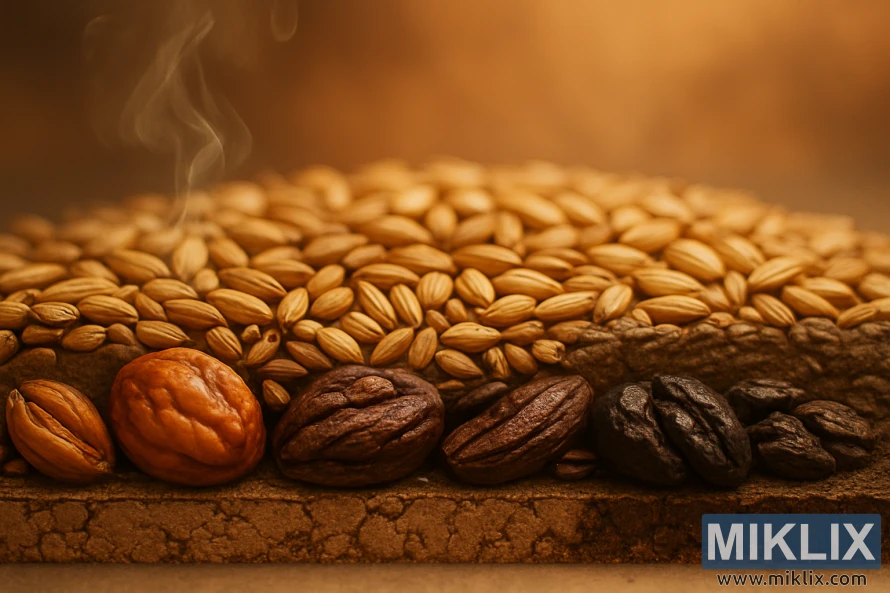
Commercial Brewing Applications
Commercial breweries often choose Dehusked Carafa for its versatility and rich flavor. It's highly valued in the craft brewing world. This malt adds depth and complexity to many beer styles.
Dehusked Carafa brings a smoother roast flavor to beers, reducing bitterness and astringency. It's perfect for brewers aiming to craft balanced and refined beers. It's used in dark ales, stouts, porters, and specialty beers.
- Enhances flavor complexity
- Provides a smooth roast character
- Ideal for various beer styles
By using Dehusked Carafa, commercial brewers can create unique flavor profiles. This sets their beers apart in a competitive market. Its versatility and quality make it a favorite among brewers.
Expert Tips for Maximum Extract Efficiency
Maximizing extract efficiency is key for brewers using Dehusked Carafa malt. To get there, optimizing mashing and brewing techniques is essential. It's vital to understand the malt's diastatic power, as it impacts the conversion of starches into fermentable sugars.
Getting the mashing temperature and time right is also critical. A temperature range of 152°F to 155°F (66°C to 68°C) is often advised for Dehusked Carafa. This range supports optimal starch conversion. Also, the mash should not be too thick, as this can hinder the extraction process.
Water chemistry is another significant factor in achieving maximum extract efficiency. Brewers need to adjust their water chemistry to align with Dehusked Carafa's specific needs. This ensures the pH and mineral levels are optimal for mashing.
Some key tips for maximizing extract efficiency include:
- Using a well-modified malt like Dehusked Carafa
- Optimizing mashing temperature and time
- Adjusting water chemistry to match the malt's requirements
- Ensuring adequate lautering and sparging techniques
By following these expert tips, brewers can significantly boost their extract efficiency. This leads to higher-quality beers with enhanced flavor and character.
Conclusion
Mastering Dehusked Carafa is a valuable skill for brewers aiming to craft complex, balanced beers. This versatile malt is perfect for a wide range of beer styles, from dark ales to stouts.
Understanding Dehusked Carafa's flavor profile, usage rates, and brewing techniques is key. Whether you're a commercial brewer or a homebrewer, adding Dehusked Carafa to your recipes can elevate your beers. It sets them apart from others.
The success of using Dehusked Carafa depends on balancing its characteristics with other malts and ingredients. As discussed, the right techniques and guidelines are essential. They help achieve the desired flavor and color in your beers.
In conclusion, Dehusked Carafa is an excellent addition to any brewer's toolkit. By mastering its use, you'll create unique and delicious beers. These beers will showcase the malt's distinct qualities, enriching your brewing repertoire.
Further Reading
If you enjoyed this post, you may also like these suggestions:
